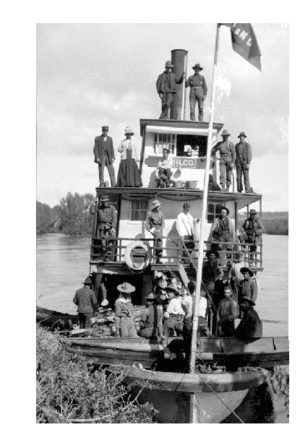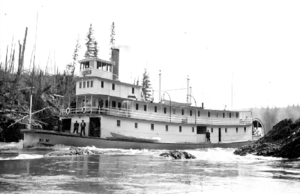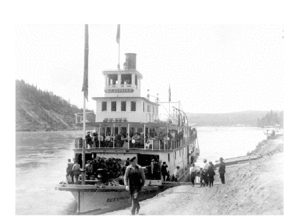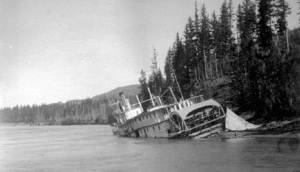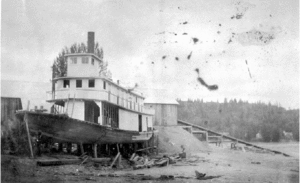Steamboats of the Upper Fraser River facts for kids
Twelve paddlewheel steamboats traveled the upper Fraser River in British Columbia from 1863 to 1921. These boats were super important! They helped build railroads, delivered mail, and brought new settlers to places like Quesnel, Barkerville, and Fort George. Some boats only went between Soda Creek and Quesnel. Others traveled much farther, even to Tête Jaune Cache, or explored the Nechako River to places like Fort Fraser.
Contents
Early Steamboats: The Wright Boats
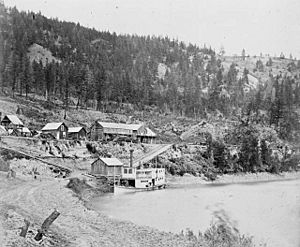
The very first steamboat on the upper Fraser River was the Enterprise. It was built in 1862 near Alexandria. Captain Thomas Wright and Gustavus Blin Wright owned and operated it. The Enterprise ran between Soda Creek and Quesnel from 1863 to 1871. After that, the Wrights took it to Takla Landing for the Omineca Gold Rush. This was its last trip, and the boat was left there.
Another steamboat, the Victoria, was also built for the Wrights. It was built in Quesnel and started service in 1869. The Victoria worked for seventeen years before it was docked near Alexandria.
The Charlotte and the Quesnel
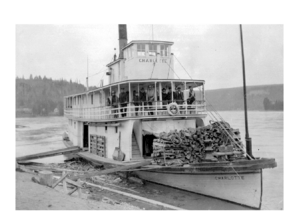
For ten years, there were no steamboat services in the area. Then, in 1896, the Charlotte was built. It was owned by the North British Columbia Navigation Company. This company was started by important people like Senator James Reid, Captain John Irving, and Stephen Tingley. Tingley owned the BC Express Company at the time.
Captain Frank Odin was the first pilot of the Charlotte. He was her captain until he passed away in 1899. Later, Captain Owen Forrester Browne became her pilot in 1909. The Charlotte was the only steamboat on the upper Fraser until 1909. That's when it was announced that the Grand Trunk Pacific Railway would cross the Fraser River at Fort George.
The Quesnel was launched by Telesphore Marion, a local merchant. It became the fourth steamboat to work the upper Fraser and was also the last. Captain DA Foster was its pilot.
The Nechacco joined the Charlotte and the Quesnel in May 1909. This boat was later renamed the Chilco (you can see a picture of it at the top of this page!). Donald McPhee built it for the Fort George Lumber and Navigation Company. Captain John Bonser, an experienced pilot, guided the Nechacco. It was the first steamboat to travel through the dangerous Grand Canyon of the Fraser.
The Fort George Lumber and Navigation Company then built the Fort Fraser. In 1910, this boat was the first to travel the route to Tête Jaune Cache. Like the Chilco, it also made trips on the Nechako River for Frank Swannell. Captain Bonser also piloted the Fort Fraser. Captain George Ritchie took command of the Chilco later in 1910. Sadly, the Chilco was destroyed in April 1911 by the icy waters of the Fraser River.
To compete with the BC Express Company, the Fort George Lumber and Trading Company built a third steamboat in 1910, the Chilcotin. Captain Arthur Frances Dogherty piloted this boat.
The BC Express Company's Steamboats
The BC Express Company had been moving goods in the area since the 1860s, during the Cariboo Gold Rush. They knew the railway would bring big changes to this area. Thousands of construction workers would soon be working between Tête Jaune Cache and Fort George. Also, millions of acres of land would open for new settlements.
Charles Vance Millar owned the BC Express Company. He bought it in 1897. Millar decided to build two large and fancy steamboats to meet the growing demand. Both were built at Soda Creek by Alexander Watson Junior.
The first company steamboat, the BX, was launched in May 1910. Captain Owen Forrester Browne piloted it. The BX had rooms for seventy passengers and could carry sixty more on its deck. It had a covered paddlewheel, so there was no water splashing, and passengers could enjoy a great view from the back. The BX even had hot and cold running water and steam heat! It quickly became the favorite for passengers and won the government mail contract.
The BX was the only steamboat that offered trips twice a week from Soda Creek to Fort George. On Sunday and Wednesday mornings, it would leave Soda Creek very early, around 3 AM. It would reach Quesnel around noon. After dropping off mail and supplies, it would continue upriver until dark. The crew would then stop to load more wood for fuel. This was called wooding up and was a common activity. Steamboats used a lot of wood, sometimes four cords an hour when going upstream! The BX would arrive in Fort George the next day, usually around 11 AM. Return trips downriver were much faster. It would leave Fort George at 7 AM on Tuesdays and Saturdays, arriving back in Soda Creek by 4:30 PM the same day.
For the 1911 season, the BC Express Company built a second steamboat, the BC Express. It was very similar to the BX, just a bit smaller and without the covered paddlewheel. Captain Joseph P Bucey piloted it. The BC Express worked the route from Fort George to Tête Jaune Cache until 1913. Then, it joined its sister ship, the BX, on the Soda Creek to Fort George route. Both boats helped with the construction of the Pacific Great Eastern Railway.
In 1915, only the BX worked on the Fraser. In 1916 and 1917, there were no steamboats at all. The BX returned to the river in 1918, still with Captain Browne. The BC Express joined it when needed.
Then, in August 1919, the BX hit a hidden rock called "Woodpecker" and sank in the Fort George Canyon. It was carrying 100 tons of concrete. Its sister ship towed it back to Quesnel for repairs, but the BX never sailed again.
George Hammond's Steamboat
George Hammond, who was promoting the Central Fort George townsite, started the Fort George Lake and River Transportation Company. He built the tenth steamboat, the Robert C Hammond. He built it so he could truthfully tell potential buyers that his community had steamboat service. Hammond had tried to get the BC Express boats to visit his community, but the Nechako River was often too shallow for those big boats.
Grand Trunk Pacific's Steamboats
When the Grand Trunk Pacific Railway reached Tête Jaune Cache in 1912, they could use their own steamboats. These boats transported workers and supplies up and down the river. The Operator and the Conveyor had worked on the Skeena River. They were taken apart in Victoria. Their engines and boilers were moved by train to Jasper, Alberta. Then, they were pulled by mule wagons to Tête Jaune Cache. There, they were put back together to be used on the river between Tête Jaune Cache and Fort George. Captain 'Con' Myers and Captain Jack Shannon were their captains. When their work was done, their parts were reused, and the boat hulls were left by the Fraser River near Prince George.
The End of an Era
The Quesnel was the last steamboat on the upper Fraser River. Captain Foster piloted her for the last time in April 1921. After that, she was wrecked on the rocks of the Fort George Canyon. This marked the end of the steamboat era on the upper Fraser.


